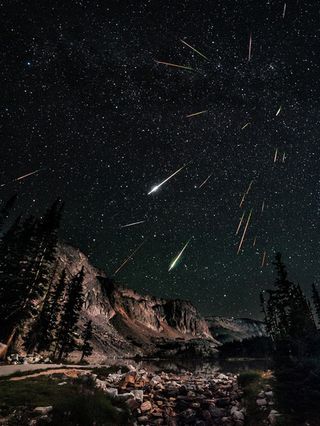Intense Perseid Meteor Shower Peaks Tonight: How to Watch Online (and Off)

The 2016 Perseid meteor shower will peak late tonight, and if you can't watch it in person, a plethora of live webcasts have you covered.
Earth has been passing through the trail of Comet Swift-Tuttle for the past few weeks, and will reach the heart of the debris — causing a peak rate of meteors burning up in Earth's atmosphere — overnight tonight, Aug. 11-12.
If you're in the Northern Hemisphere, head outside after the moon sets (around 12-1 a.m. depending on your location) for the ultimate shooting-star views. But if you're in for a cloudy, rainy night, live somewhere with too much light pollution or just want to head in early for the night, there are lots of live webcasts to tune in to and still experience the shower. [Perseid Meteor Shower 2016: When, Where & How to See It]
Slooh Community Observatory will host a marathon 4-hour-long broadcast starting tonight at 8 p.m. EDT (0000 GMT on Aug. 12), which you can watch live on the Slooh website. The webcast will incorporate live views of the meteors from observatories in four different countries: Spain's Canary Islands; Washington, Connecticut in the United States; the United Kingdom; and Canada's Thunder Bay.
You can also watch the Perseids meteor shower webcast on Space.com, courtesy of Slooh. The observatory will also discuss the best ways to watch, how to catch meteor photos and the history behind the constellation Perseus, the shower itself and Comet Swift-Tuttle.

Tomorrow, starting at 9 p.m. EDT (1300 GMT), Slooh will continue to cover the Perseids with the help of Weathernews Japan.
"With December's Geminids spoiled by a full moon, these Perseids will be the best shower of 2016," Slooh host Bob Berman said in a statement. "Add to that the juicy peril of its parent comet, Swift-Tuttle, the most hazardous object in the known universe, and you have all the ingredients for a 4-star spectacle."
Get the Space.com Newsletter
Breaking space news, the latest updates on rocket launches, skywatching events and more!
NASA will host its own live webcasts starting at 10 p.m. EDT both tonight and Friday (0200 GMT Friday and Saturday) for any space enthusiasts with obstructed views.
Also covering Thursday night's meteor shower peak, the Virtual Telescope Project, run by astronomer Gianluca Masi in Italy, will stream a live show starting at 9 p.m. EDT (0100 GMT on Friday). Meanwhile, the Bareket Observatory in Israel will also host a webcast starting at 7 p.m. EDT (1900 GMT on Friday).

Because the Perseids are in outburst this year, there might be as many as 200 meteors per hour streaking across the sky tonight. So whether you plan to watch outside late tonight or follow a live webcast, get ready: It's going to be quite a show.
Editor's note: If you catch an awesome photo of the Perseid meteor shower that you'd like to share with Space.com and our news partners for a possible story or image gallery, please contact managing editor Tariq Malik at spacephotos@space.com.
Email Sarah Lewin at slewin@space.com or follow her @SarahExplains. Follow us @Spacedotcom, Facebook and Google+. Original article on Space.com.
Join our Space Forums to keep talking space on the latest missions, night sky and more! And if you have a news tip, correction or comment, let us know at: community@space.com.

Sarah Lewin started writing for Space.com in June of 2015 as a Staff Writer and became Associate Editor in 2019 . Her work has been featured by Scientific American, IEEE Spectrum, Quanta Magazine, Wired, The Scientist, Science Friday and WGBH's Inside NOVA. Sarah has an MA from NYU's Science, Health and Environmental Reporting Program and an AB in mathematics from Brown University. When not writing, reading or thinking about space, Sarah enjoys musical theatre and mathematical papercraft. She is currently Assistant News Editor at Scientific American. You can follow her on Twitter @SarahExplains.
